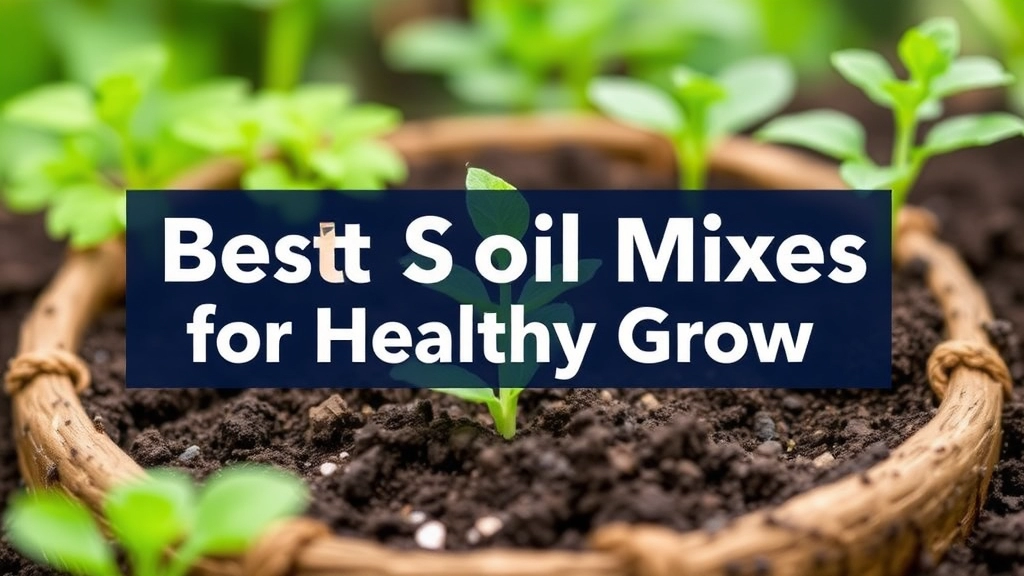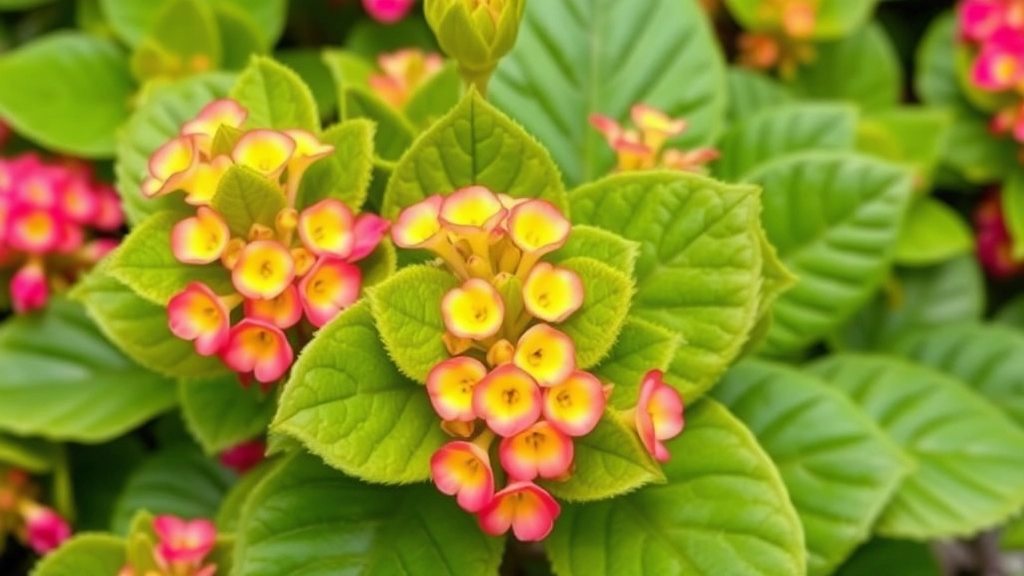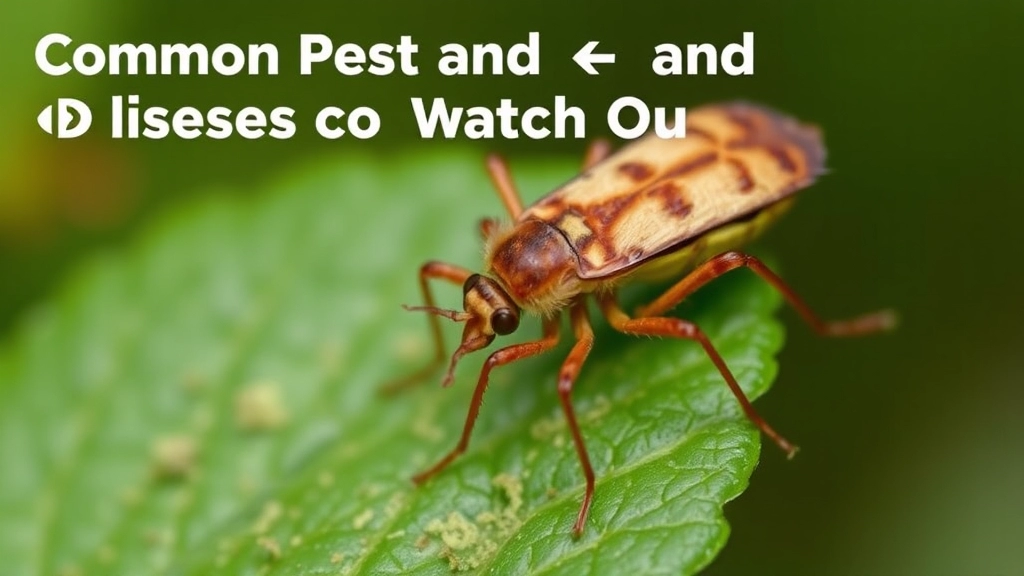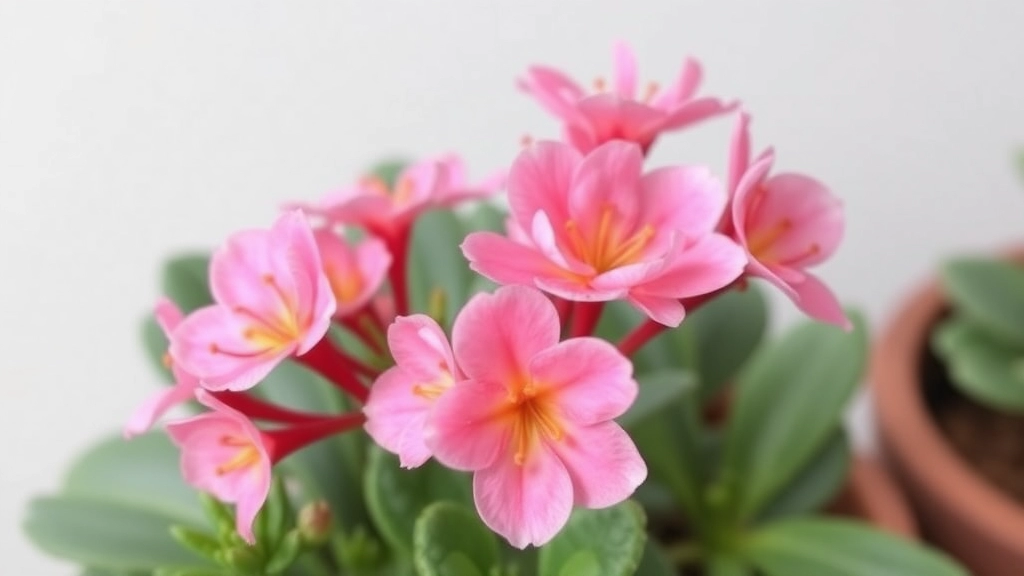Kalanchoe Blossfeldiana Hybrid Care
When it comes to Kalanchoe Blossfeldiana Hybrid care, getting the basics right is key to enjoying vibrant blooms and healthy growth. First, ensure your plant receives bright, indirect light to thrive. Too much direct sunlight can scorch the leaves, while too little light can hinder blooming. A well-draining soil mix is also crucial; think cactus or succulent soil to prevent root rot.
Watering
Watering is another vital aspect. Allow the soil to dry out between waterings to avoid overwatering, which is a common issue. Fertilise sparingly during the growing season to promote vibrant blooms. Deadheading spent flowers and occasional pruning can encourage prolonged flowering and a bushier plant.
Propagation and Pests
Want to propagate? Stem cuttings and offsets are effective methods. Keep an eye out for common pests like aphids and mealybugs, and ensure your plant stays in a warm, humid environment for optimal health.
Ideal Lighting Conditions for Kalanchoe Blossfeldiana Hybrids
Are you struggling to get your Kalanchoe Blossfeldiana hybrids to thrive? One of the most critical factors in their care is lighting.
Kalanchoe Blossfeldiana hybrids flourish under specific lighting conditions that mimic their native environment.
Optimal Light Exposure
- Bright, Indirect Light: These plants prefer bright light but can easily scorch in direct sunlight.
- Duration: Aim for around 12-14 hours of light daily.
- South or West Windows: Position your plants near these windows for the best results.
If you’re using artificial lights, ensure they provide sufficient brightness without overheating the plant.
Signs of Inadequate Lighting
Keep an eye out for these signs that your Kalanchoe may not be getting enough light:
- Leggy Growth: Stems stretching towards the light source.
- Few Flowers: A lack of blooms can indicate insufficient light.
- Yellowing Leaves: This may signal stress from inadequate lighting.
For more detailed information on fixing etiolated Kalanchoe Blossfeldiana and ensuring proper lighting, check out our comprehensive guide. Additionally, if you want to know how to grow and care for flowering Kalanchoe Blossfeldiana, we have all the tips you need.
Best Soil Mixes for Healthy Growth

Now that we’ve set the stage for growing Kalanchoe Blossfeldiana hybrids, let’s dive into one of the most crucial aspects: soil.
You might be wondering, “What type of soil do my Kalanchoe need for healthy growth?”
Well, the right soil mix can make all the difference.
Key Ingredients for the Perfect Soil Mix
- Well-Draining Soil: Kalanchoe hybrids thrive in soil that drains well. This prevents root rot, which can be a real killer for these beauties.
- Cactus or Succulent Mix: A pre-made cactus or succulent mix is often ideal. It’s designed to provide the drainage these plants crave.
- Perlite or Pumice: Mixing in some perlite or pumice can improve aeration and drainage. Just a handful can work wonders!
- Organic Matter: Adding a bit of compost can boost nutrients without making the soil too heavy.
DIY Soil Mix Recipe
If you’re feeling adventurous, here’s a simple recipe for a homemade mix:
- 1 part potting soil
- 1 part perlite or pumice
- 1 part sand (make sure it’s coarse)
Mix these ingredients well, and you’ve got yourself a fantastic potting mix!
Tips for Soil Maintenance
- Check pH Levels: Kalanchoe prefers slightly acidic to neutral soil (pH 6.0-7.0).
- Repotting: Consider repotting every couple of years to refresh the soil and give those roots more room to grow.
Proper Watering Techniques to Prevent Overwatering
When caring for Kalanchoe Blossfeldiana hybrids, one of the most common concerns is watering. How do you ensure your plant thrives without drowning it?
Understanding the Plant’s Needs
Kalanchoe hybrids are succulents, which means they store water in their leaves. This adaptation makes them particularly susceptible to overwatering. Here are some straightforward techniques to keep your plant healthy:
- Check the Soil Moisture: Before watering, always check if the top inch of soil is dry. Stick your finger in; if it feels moist, hold off on watering.
- Watering Schedule: During the growing season (spring and summer), water every 2-3 weeks. In the dormant season (fall and winter), reduce this frequency to once a month.
- Use Well-Draining Soil: A soil mix that promotes drainage is crucial. Look for a blend specifically designed for succulents, or mix regular potting soil with sand or perlite.
- Watering Technique: Water thoroughly until you see excess moisture draining from the bottom of the pot. Ensure the pot has drainage holes to prevent water from pooling.
- Observe the Plant: Yellowing leaves or a mushy stem can indicate overwatering. If you notice these signs, allow the soil to dry out completely before watering again.
For more detailed advice on keeping your plant healthy, check out this guide on lighting and care tips. Additionally, if you’re interested in learning about the various colors of Kalanchoe Blossfeldiana, we have a complete guide available.
Fertilization Strategies for Vibrant Blooms

As we explore the essential care practices for Kalanchoe Blossfeldiana hybrids, fertilization plays a pivotal role in ensuring your plants flourish with vibrant blooms.
Understanding Nutritional Needs
Kalanchoe hybrids thrive when provided with the right nutrients. The key is to use a balanced fertiliser that supports both growth and flowering.
- Type of Fertiliser: Opt for a water-soluble fertiliser with a balanced N-P-K ratio, such as 20-20-20 or 15-30-15.
- Frequency: Fertilise every 4-6 weeks during the growing season (spring and summer) to promote healthy growth and abundant blooms.
Timing is Everything
When you fertilise can significantly impact your plant’s performance.
- Start Early: Begin fertilising as soon as you notice new growth in spring.
- Cease in Winter: Reduce or stop fertilisation during the dormant winter months to prevent nutrient overload.
Application Tips
How you apply the fertiliser can make a difference.
- Dilution: Always dilute the fertiliser to half the recommended strength to avoid burning the roots.
- Watering: Apply fertiliser when the soil is slightly moist to help the nutrients absorb effectively.
Organic Options
If you prefer organic methods, consider these alternatives:
- Compost Tea: Brew compost in water and use it as a nutrient-rich liquid fertiliser.
- Fish Emulsion: A great organic option, fish emulsion provides essential nutrients and promotes healthy growth.
Deadheading and Pruning for Prolonged Flowering
Are you wondering how to keep your Kalanchoe Blossfeldiana hybrids blooming for longer?
Deadheading and pruning are essential practices that can significantly enhance the flowering period of your plants.
What is Deadheading?
Deadheading involves removing spent blooms to encourage new growth.
Here’s how it works:
- Promotes New Blooms: By cutting off faded flowers, you redirect the plant’s energy towards producing new flowers instead of seed production.
- Improves Appearance: Removing dead or wilted flowers helps maintain a tidy and attractive look.
How to Deadhead Kalanchoe:
- Identify Spent Blooms: Look for flowers that have faded or are wilting.
- Use Clean Tools: Always use sharp, clean scissors or pruning shears to avoid damaging the plant.
- Cut at the Base: Remove the flower stem at its base, just above the leaf node.
Pruning for Health and Shape
Pruning is equally important for maintaining the overall health and shape of your Kalanchoe hybrids.
Here’s how to do it effectively:
- Timing: Prune after the blooming period, typically in late spring or early summer.
- Remove Leggy Growth: Trim back any long or leggy stems to encourage bushier growth.
- Focus on Dead Leaves: Remove any yellow or dead leaves to promote airflow and reduce disease risk.
- Shape Your Plant: Shape the plant as needed, ensuring it remains compact and healthy.
By incorporating deadheading and pruning into your care routine, you’ll not only prolong the blooming period but also enhance the overall vitality of your Kalanchoe. For more detailed tips, check out our guide on Kalanchoe Blossfeldiana flowering period care tips and learn about the optimal care for Kalanchoe Blossfeldiana growth.
How to Encourage Reblooming in Kalanchoe Hybrids

So, you’ve enjoyed the stunning blooms of your Kalanchoe Blossfeldiana hybrids, but now you’re wondering how to coax them into blooming again. It’s a common concern, and I get it—who doesn’t want their plants to keep showing off?
Here’s the lowdown on encouraging those vibrant flowers to return:
1. Light It Up
- Bright Indirect Light: Ensure your Kalanchoe gets plenty of bright, indirect sunlight. Too much direct sun can scorch the leaves, while too little can stifle blooming.
- Rotate Your Plant: Give it a gentle turn every now and then to promote even growth and blooming.
2. Prune After Blooming
- Cut Back Spent Flowers: Snip off the dead blooms to encourage new growth.
- Trim Back Foliage: If the leaves look leggy, don’t hesitate to prune them back a bit.
3. Control Watering
- Let It Dry: Allow the soil to dry out between waterings. Overwatering can lead to root rot, which halts blooming.
- Water Sparingly: During the dormant period, cut back on watering. This encourages the plant to focus on blooming when the time is right.
4. Feed Wisely
- Use a Balanced Fertilizer: Apply a diluted liquid fertilizer every couple of weeks during the growing season. Look for something high in phosphorus to promote blooms.
- Stop Feeding When Dormant: Once your plant goes dormant, ease up on the fertiliser to let it rest.
5. Temperature Check
- Cool Nights: A slight drop in temperature at night can encourage blooming. Aim for around 10-15°C (50-59°F) during the night.
- Keep It Cozy: During the day, a warmer environment helps stimulate growth.
6. Give It a Rest
- Dormancy Period: After blooming, give your Kalanchoe a break. Reduce light and water to mimic natural conditions. This helps it recharge for the next blooming cycle.
Effective Propagation Methods: Stem Cuttings and Offsets
Are you looking to expand your collection of Kalanchoe Blossfeldiana hybrids without breaking the bank? Propagation is a fantastic way to achieve this, and there are two primary methods to consider: stem cuttings and offsets. Both techniques are straightforward and can lead to healthy new plants.
Stem Cuttings
Using stem cuttings is one of the most popular ways to propagate Kalanchoe. Here’s how to do it effectively:
- Select a Healthy Stem: Choose a robust, healthy stem with several leaves.
- Make the Cut: Using clean, sharp scissors, cut a 10-15 cm section just below a leaf node.
- Let It Callous: Place the cutting in a dry, warm area for a few hours to allow the cut end to callous over. This step helps prevent rot.
- Plant the Cutting: Insert the calloused end into a well-draining soil mix, ideally one designed for succulents.
- Water Sparingly: Water lightly after planting, then keep the soil slightly moist but not soggy.
Offsets
Offsets, or “pups,” are small plants that grow around the base of the parent plant. They are another excellent way to propagate Kalanchoe:
- Identify Offsets: Look for small plants attached to the main stem.
- Remove Carefully: Gently twist or cut the offset away from the parent plant, ensuring some roots are attached.
- Prepare for Planting: Allow the offset to dry for a day or two before planting to prevent rot.
- Plant in Soil: Use the same well-draining mix as with stem cuttings.
- Water and Care: Water lightly and place the new plant in a bright, indirect light location.
Both methods provide an opportunity to grow new Kalanchoe plants without the need for seeds or expensive purchases. For more detailed guidance, you can refer to our how to propagate Kalanchoe Blossfeldiana cuttings and family care, propagation, and uses pages.
Common Pests and Diseases to Watch Out For

So, you’ve got your Kalanchoe Blossfeldiana thriving, but what happens when uninvited guests crash the party? Pests and diseases can sneak in and ruin all your hard work. Here’s what to keep an eye on:
Pests to Watch For:
- Aphids: Tiny green or black bugs that suck the sap from your plant. They can cause stunted growth and yellowing leaves.
- Mealybugs: Look for white, cottony masses on the leaves. They can weaken your plant and lead to mold issues.
- Spider Mites: These little guys thrive in dry conditions. You might spot fine webbing on your leaves, and they can cause leaf drop.
- Scale Insects: They look like small bumps on the stems and leaves. They can be tricky to spot but can really sap your plant’s strength.
Diseases to Keep an Eye On:
- Powdery Mildew: A white, powdery substance on leaves, often due to high humidity. It can stunt growth and ruin those lovely blooms.
- Root Rot: Usually caused by overwatering, look for wilting leaves and a mushy stem. This can be a real killer for your plant.
- Leaf Spot: Dark spots on leaves can indicate fungal infections. If left untreated, they can spread quickly.
Prevention Tips:
- Regular Checks: Make it a habit to inspect your plants weekly. Catching pests early makes a world of difference.
- Cleanliness: Keep the area around your Kalanchoe tidy. Remove any dead leaves or debris that might attract pests.
- Proper Watering: Avoid overwatering to prevent root rot. Let the soil dry out between waterings.
- Natural Remedies: Consider using insecticidal soap or neem oil for pest control. They’re effective and usually safe for your plant.
Temperature and Humidity Requirements
When caring for Kalanchoe Blossfeldiana hybrids, understanding their temperature and humidity needs is crucial for thriving plants.
What Temperature is Ideal?
Kalanchoes prefer a warm environment.
- Daytime Temperatures: Aim for 20°C to 25°C (68°F to 77°F).
- Nighttime Temperatures: A drop to about 15°C (59°F) is acceptable.
- Avoid Frost: These plants are sensitive to cold; temperatures below 10°C (50°F) can be harmful.
Humidity Levels
Kalanchoes thrive in moderate humidity.
- Optimal Range: 40% to 50% humidity is ideal.
- Avoid Excess Moisture: High humidity can lead to fungal issues.
Tips for Maintaining Ideal Conditions
- Indoor Care: Use a room with good air circulation.
- Outdoor Placement: If you’re growing them outside, ensure they’re in a sheltered spot away from cold winds.
- Monitor Temperature: Use a thermometer to keep track of the environment.
- Propagation Tips: Learn how to propagate Kalanchoe Blossfeldiana cuttings for a thriving garden.
- Comprehensive Care: For more detailed information, refer to the ultimate guide to Kalanchoe Blossfeldiana hybrid care.
Toxicity Considerations for Pets and Families

When it comes to bringing Kalanchoe Blossfeldiana hybrids into our homes, there’s a crucial aspect we must address: toxicity.
Are Kalanchoe plants safe for pets and kids?
Kalanchoe hybrids are undeniably beautiful, but they can be harmful if ingested. Here’s what you need to know:
- Toxic to Pets: Kalanchoe contains compounds called bufadienolides, which can be toxic to dogs and cats. Symptoms of ingestion may include:
- Vomiting
- Diarrhoea
- Lethargy
- Heart issues in severe cases
- Caution for Kids: While Kalanchoe isn’t highly toxic to humans, it’s still best to keep these plants out of reach of small children. Accidental ingestion might lead to mild stomach upset.
- Signs to Watch For: If you suspect your pet or child has consumed Kalanchoe, keep an eye out for:
- Unusual behaviour
- Changes in appetite
- Signs of distress
What to Do If Ingested?
- Immediate Action: If you think your pet has eaten Kalanchoe, contact your vet right away.
- For Kids: If a child has ingested any part of the plant, seek medical advice promptly.
To keep your home safe while enjoying the beauty of Kalanchoe, consider placing them on high shelves or in areas that are off-limits to pets and young children.
Creative Indoor and Outdoor Uses of Kalanchoe Blossfeldiana
Are you looking for ways to incorporate Kalanchoe Blossfeldiana into your living spaces?
These vibrant, flowering succulents can brighten both indoor and outdoor environments, making them a versatile choice for plant enthusiasts.
Indoor Uses
- Table Centrepieces:
- Use Kalanchoe as a stunning centrepiece on dining or coffee tables.
- Pair with decorative pots for added flair.
- Window Sills:
- They thrive in bright light, making window sills an ideal spot.
- Group different colours for a lively display.
- Office Decor:
- A small pot can liven up a workspace.
- Their low maintenance nature means you can enjoy blooms without constant care.
- Gift Ideas:
- Kalanchoe makes a thoughtful gift for plant lovers.
- Consider pairing with a charming pot or a care guide.
Outdoor Uses
- Garden Borders:
- Plant them along pathways for a splash of colour.
- Their compact size makes them perfect for edging.
- Rock Gardens:
- Kalanchoe fits beautifully into rock gardens, adding texture and colour.
- Mix with other succulents for a diverse landscape.
- Patio Displays:
- Create vibrant displays in pots on patios or balconies.
- Combine with other flowering plants for an eye-catching arrangement.
- Seasonal Arrangements:
- Use Kalanchoe in seasonal garden displays.
- Their long blooming period ensures they remain a focal point. For more ideas, check out our complete guide.
FAQs on Kalanchoe Blossfeldiana Hybrid Care
What type of soil is best for Kalanchoe Blossfeldiana hybrids?
Kalanchoe hybrids thrive in well-draining soil. A cactus or succulent mix is ideal, and adding perlite or pumice can improve aeration and drainage.
Can I make my own soil mix for Kalanchoe?
Yes, you can make a DIY soil mix using 1 part potting soil, 1 part perlite or pumice, and 1 part coarse sand. Mix these ingredients well for a fantastic potting mix.
How often should I fertilize my Kalanchoe hybrids?
Fertilize every 4-6 weeks during the growing season (spring and summer) with a balanced, water-soluble fertilizer. Reduce or stop fertilization during the dormant winter months.
What kind of light do Kalanchoe hybrids need?
Kalanchoe hybrids need bright, indirect sunlight. Too much direct sun can scorch the leaves, while too little light can stifle blooming.
How can I encourage my Kalanchoe to rebloom?
To encourage reblooming, ensure your plant gets bright indirect light, prune after blooming, control watering, use a balanced fertilizer, and maintain appropriate temperature conditions.
What are common pests and diseases affecting Kalanchoe hybrids?
Common pests include aphids, mealybugs, spider mites, and scale insects. Diseases to watch for include powdery mildew, root rot, and leaf spot.
How can I prevent pests and diseases in my Kalanchoe?
Regularly inspect your plants, keep the area clean, avoid overwatering, and use natural remedies like insecticidal soap or neem oil for pest control.
Are Kalanchoe hybrids toxic to pets and children?
Yes, Kalanchoe hybrids can be toxic to pets due to compounds called bufadienolides. They can cause vomiting, diarrhea, lethargy, and even heart issues in severe cases. While not highly toxic to humans, it’s best to keep them out of reach of small children to avoid mild stomach upset.
What should I do if my pet or child ingests Kalanchoe?
If you suspect ingestion, contact your vet immediately for pets or seek medical advice promptly for children. Look out for unusual behavior, changes in appetite, or signs of distress.
How often should I repot my Kalanchoe hybrids?
Consider repotting every couple of years to refresh the soil and give the roots more room to grow. This helps maintain healthy growth and vibrant blooms.
References
-
Kalanchoe Plant Care: How To Grow A Kalanchoe
-
How to Grow and Care for Kalanchoe
-
Kalanchoe: How to Grow and Care for Kalanchoe Plants
